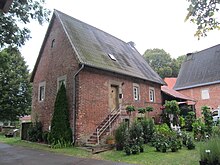Schinna Monastery

Monastery Schinna is a former Benedictine - monastery in the district Schinna in the unified community Stolzenau in Lower Saxony Nienburg / Weser .
history
The monastery is a foundation of Count Wilbrand I von Loccum-Hallermund on his estates west of the Weser from the year 1148. Wilbrand was a son of Count Burchard von Loccum (de Lucca), who officiated as Count of Friesland. Since the abbey is located directly on the Weser, it is likely that Wilbrand wanted to create a base on the way to his Frisian possessions, in addition to a souls health foundation. The consecration took place in 1153 to Saint Vitus and in 1155 it was confirmed by the Bishop of Minden, Werner from Bückeburg . In 1234, seven monks are mentioned in a document, although the convent was possibly larger. In 1466 the monastery joined the Bursfeld congregation and since then the Counts of Hoya have held the church patronage. Under pressure from Count Erich von Hoya, the monastery had to renounce its land use in the first third of the 16th century. There was also a ban on accepting novices , so the decline of the monastery was inevitable. When the abbot Friedrich von Soltau died in 1537, the count wanted to secularize the monastery . The general chapter of the Bursfeld congregation prevented this. The Reformation prevailed in Schinna with the appointment of a Lutheran pastor in 1542, when the convent only consisted of five members. After the dynasty of the Counts of Hoya died out in 1582, the monastery was leased and later used as the outbuilding of the Stolzenau office. In 1876 the monastery was finally dissolved when it was converted into a state domain .

In 2014, a country party was held for the first time on the monastery grounds .
building
The current building stock of the former monastery comprises four buildings. These include the abbot's house, the western and southern wings of the convent building and the half-timbered church. According to the building researcher Stefan Amt, the two remaining convent buildings were built in the 13th and 14th centuries. During their agricultural use they were used, among other things, as a tractor barn and a grain silo. The Gothic monastery church was demolished before 1540 at the behest of Count Erich von Hoya and the stones were supposedly used to enlarge the castle in Stolzenau. In place of the monastery church a half-timbered church was built, which could be dendrodated to the year 1539/40 . From the point of view of the preservation of monuments, it is the most important building in the monastery because of its structural details and also because it was built in the transition period to the Reformation. Until the mid-1980s the church was used as a pig and sheep pen.
The rest of the building stock on the site belongs to the former domain, which was owned by the State of Lower Saxony until 2005 and had been farmed until then. Since then, the total of eleven buildings on the property have not been used and are empty. The domain buildings have the character of a large agricultural enterprise and date from the middle of the 19th and the first third of the 20th century.
archeology
Between 2009 and 2011, archaeological excavations took place annually on the site of the former Benedictine abbey. In 2010 the facility was examined using georadar . On the basis of these results, narrow archaeological probes were created in order to specifically research the former monastery. During the excavations, the foundations of the abandoned eastern convent building were exposed. Of the Romanesque monastery church, only the excavated trench filled with rubble could be documented. The ground plan of the church building can be partially reconstructed along its course. In addition, the rubble provided details that suggest the construction and equipment of the church. The choir area of the monastery church could be recorded, whereby the excavations refuted an initially assumed choir expansion through the excavation. In 2010, the remains of burials in the former cloister of the monastery were uncovered and recovered. Anthropological studies are currently (2012) taking place at the LMU Munich . In 2011, the foundation of a late medieval building to the west of the enclosure was excavated.
Since April 2012, a small exhibition in the half-timbered church on the monastery grounds has been providing information about the results of the archaeological campaigns from 2009 to 2011.
Walled-up cloister , former blacksmith shop on the left
literature
- Schinna (in it: Former Benedictine monastery St. Vitus, today domain. ) In: Georg Dehio : Handbuch der Deutschen Kunstdenkmäler . Bremen Lower Saxony. Deutscher Kunstverlag, Munich / Berlin 1992, ISBN 3-422-03022-0 , page 1168 f.
- Stefan Amt : The monastery and domain complex in Schinna, Nienburg / Weser district in: Reports on the preservation of monuments in Lower Saxony , 1/2007 ( online , pdf)
- Jens Berthold / S. Neupert / B. Päffgen, Archeology in Schinna In: Archeology in Lower Saxony (AiN) 14, 2011, 109–112.
Web links
- Website of the Schinna Monastery Foundation
- Final report on the investigations from 2010 to 2012 in the Schinna monastery by the municipal archeology of the Schaumburg landscape (pdf; 1.8 MB)
- Description of Schinna Monastery on the Lower Saxony monastery map of the Institute for Historical Research
Coordinates: 52 ° 32 ′ 11.8 " N , 9 ° 4 ′ 33.9" E






